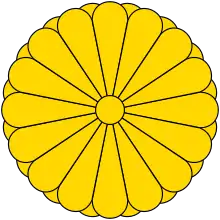Cabinet of Japan
The Cabinet of Japan (Japanese: 内閣, Hepburn: Naikaku) is the executive branch of the government of Japan. It consists of the Prime Minister, who is appointed by the Emperor after being designated by the National Diet, and up to nineteen other members, called Ministers of State. The Prime Minister is designated by the Diet, and the remaining ministers are appointed and dismissed by the Prime Minister. The Cabinet is collectively responsible to the Diet and must resign if a motion of no confidence is adopted by the Diet.
 |
|---|
| This article is part of a series on the politics and government of Japan |
|
|

Appointment
Under the constitution, Cabinet ministers are appointed after the selection of the Prime Minister. A majority of the Cabinet, including the Prime Minister, must be members of the Diet, and all members must be civilians. Under the Cabinet Law, the number of Cabinet Ministers (excluding the Prime Minister) must be fourteen or less, but this may be increased to nineteen if a special need arises. In the event that the Cabinet collectively resigns it continues to exercise its functions until the appointment of a new Prime Minister. While they are in office, legal action may not be taken against Cabinet ministers without the consent of the Prime Minister. The Cabinet must resign en masse in the following circumstances:
- When a motion of no confidence is adopted, or a vote of confidence defeated, by the House of Representatives, unless there is a dissolution of the house within ten days.
- Upon the first convocation of the Diet after a general election to the House of Representatives (even if the same Prime Minister is to be re-elected and appointed, and every other minister is to be reappointed).
- When the position Prime Minister becomes vacant, or the Prime Minister declares his intention to resign.
Powers
The Cabinet exercises two kinds of power. Some of its powers are nominally exercised by the Emperor with the binding "advice and approval" of the Cabinet. Other powers are explicitly vested in the Cabinet. Contrary to the practice in many constitutional monarchies, the Emperor is not even the nominal Chief Executive. Instead, the Constitution explicitly vests executive authority in the Cabinet. Hence, nearly all of the day-to-day work of governing is done by the Cabinet.
In practice, much of the Cabinet's authority is exercised by the Prime Minister. Under the Constitution, the Prime Minister exercises "control and supervision" over the executive branch, and no law or Cabinet order can take effect without the Prime Minister's countersignature (and the Emperor's promulgation). While Cabinet Ministers in most other parliamentary democracies theoretically have some freedom of action (within the limits of cabinet collective responsibility), the Japanese Cabinet is effectively an extension of the Prime Minister's authority.
According to Article 75 of the Constitution, Ministers of State are not subject to legal action without the consent of the Prime Minister during their tenure of office.

Powers exercised via the Emperor
- Promulgation of amendments to the laws, cabinet orders and treaties.
- Convocation of the Diet.
- Dissolution of the House of Representatives.
- Proclamation of general elections to the Diet.
- Receiving of foreign ambassadors and ministers.
- Conferring of honours.
Explicit powers
- Execution of the law.
- Conduct of foreign affairs.
- Conclusion of treaties (with the consent of the Diet).
- Administration of the civil service.
- Drafting of the budget (which must be adopted by the Diet).
- Adoption of cabinet orders.
- Granting of general amnesty, special amnesty, commutation of punishment, reprieve, and restoration of rights.
- Signing of laws or cabinet orders by the relevant Minister of State and countersigned by the Prime Minister.
- Appointment of the associate justices of the Supreme Court of Japan (except for the Chief Justice, who is designated by the Prime Minister and formally appointed by the Emperor).
- Appointment of vice-ministers (who are nominated by their respective Minister to whom they will report).
Current Cabinet of Japan
The members of the current cabinet of Japan headed by the Liberal Democratic Party lawmaker Yoshihide Suga as of 16 September 2020 are as follows:[1]
| Office | Incumbent | Seat | Cabinet appointment |
|---|---|---|---|
| Prime Minister | Yoshihide Suga | House of Representatives, LDP | Leader of majority party |
| Deputy Prime Minister Minister of Finance Minister of State for Financial Services Minister in charge of Overcoming Deflation |
Tarō Asō | Reappointed | |
| Minister for Internal Affairs and Communications Minister of State for the Social Security and Tax Number System |
Ryota Takeda | New appointment | |
| Minister of Justice | Yoko Kamikawa | New appointment | |
| Minister for Foreign Affairs | Toshimitsu Motegi | Reappointed | |
| Minister of Defense | Nobuo Kishi | New appointment | |
| Minister of Education, Culture, Sports, Science and Technology Minister in charge of Education Rebuilding |
Kōichi Hagiuda | Reappointed | |
| Minister of Health, Labour and Welfare Minister in charge of Working-style Reform |
Norihisa Tamura | New appointment | |
| Minister of Agriculture, Forestry and Fisheries | Kōtarō Nogami | New appointment | |
| Minister of Economy, Trade and Industry Minister in charge of Industrial Competitiveness Minister in charge of International Exposition Minister of State for Economic Cooperation with Russia Minister in charge of the Response to the Economic Impact caused by the Nuclear Accident Minister of State for the Nuclear Damage Compensation and Decommissioning Facilitation Corporation |
Hiroshi Kajiyama | Reappointed | |
| Minister of Land, Infrastructure, Transport and Tourism Minister in charge of Water Cycle Policy |
Kazuyoshi Akaba | House of Representatives, Komeito | New appointment |
| Minister of the Environment Minister of State for Nuclear Emergency Preparedness |
Shinjirō Koizumi | House of Representatives, LDP | Reappointed |
| Chief Cabinet Secretary Minister in charge of Mitigating the Impact of U.S. Forces in Okinawa Minister in charge of the Abductions Issue |
Katsunobu Katō | New appointment | |
| Minister for Reconstruction Minister in charge of Comprehensive Policy Coordination for Revival from the Nuclear Accident at Fukushima |
Katsuei Hirasawa | New appointment | |
| Chairperson of the National Public Safety Commission Minister in charge of Administrative Reform Minister in charge of Civil Service Reform Minister in charge of Building National Resilience Minister of State for Disaster Management |
Hachiro Okonogi | New appointment | |
| Minister for Promoting Dynamic Engagement of All Citizens Minister in charge of Territorial Issues Minister of State for Okinawa and Northern Territories Affairs Minister of State for Consumer Affairs and Food Safety Minister of State for Measures for the Declining Birthrate Minister of State for Ocean Policy |
Tetsushi Sakamoto | House of Councilors, LDP | New appointment |
| Minister in charge of Information Technology Policy Minister of State for "Cool Japan" Strategy Minister of State for the Intellectual Property Strategy Minister of State for Science and Technology Policy Minister of State for Space Policy |
Taro Kono | House of Representatives, LDP | New appointment |
| Minister of State for Economic and Fiscal Policy Minister in charge of Social Security Reform Minister in charge of TPP and Japan-U.S. Trade Negotiations |
Yasutoshi Nishimura | Reappointed | |
| Minister of State for Regional Revitalization Minister of State for Regulatory Reform |
Seigo Kitamura | New appointment | |
| Minister of State for the Tokyo Olympic and Paralympic Games Minister in charge of Women's Empowerment Minister of State for Gender Equality |
Seiko Hashimoto | Reappointed |
See also
References
- The Japan Times. "Cabinet Profiles" [since 2008]. The Japan Times Online. Accessed 13 October 2012 from: https://web.archive.org/web/20040623111921/http://www.japantimes.com/cabinets.htm
- Cabinet Secretariat, Office of Cabinet Public Relations, Japan (2003). Prime Minister of Japan and His Cabinet. Retrieved 28 Oct. 2003 from: http://www.kantei.go.jp/foreign/index-e.html
- Hunter, Janet (1984). Concise Dictionary of Modern Japanese History. Berkeley and Los Angeles: University of California Press, pp. 266–324, Appendix 5: Japanese Cabinets Since the Introduction of the Cabinet System in 1885 [to 1980].
External links
Notes
- "List of Ministers (The Cabinet) | Prime Minister of Japan and His Cabinet". Retrieved 11 April 2019.

